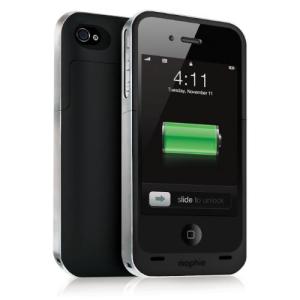 Mophie’s much-lauded external rechargeable battery case for the iPhone, the Juice Pack Air, will soon be available for the Verizon iPhone 4.
Mophie’s much-lauded external rechargeable battery case for the iPhone, the Juice Pack Air, will soon be available for the Verizon iPhone 4.
For this new model, Mophie has made the Juice Pack Air fit both the AT&T and Verizon iPhone 4, so if you soon find yourself picking one up at the store, it’s unlikely you’ll grab the wrong model and have to make an exchange. It can be pre-ordered now at Mophie’s homepage for $79.95 with an expected ship date of Monday, February 28. The AT&T version, which has been available for some time, has received positive marks for being extremely lightweight (weighing in at 2.5 ounces) and ultra-thin (adding 0.68 inches), and virtually doubling the battery life of a single charge. For a hands-on review, check out our video review of the Juice Pack Air for the iPhone 3G S.
Design highlights include:
- Soft-touch, rubberized black exterior with brushed silver band, mirroring the aesthetic of the iPhone 4 itself (a red and glossy white version is expected in late March)
- Provides traditional “case” protections against bumps, bruises & scrapes, etc.
- 1500mAh rechargeable lithium polymer battery
- Design that “acts as a virtual speaker box, redirecting sound from the bottom of the iPhone 4 to the front, resulting in a richer, fuller sound quality”
- 4 LED integrated status indicator tells you exactly how much “juice” is left and how much time remains in the charging process
- Standby-charging toggle switch to limit using the juice when you don’t need it
- Access to the USB port to sync and charge your iPhone 4 while the case is on
Mophie has been making these cases for some time now, touting over 1 million Juice Packs sold to date, which have been produced for every form factor of iPhone and iPod Touch, and was dubbed the first ever Apple-certified “Works With iPhone” battery case. But of course, it’s not the only one. Check out these alternatives:
- Energizer AP1201 for $69.99
- ExoGear Exolife for $89.95
- Tekkeon myPower for $79.95
- Case-Mate Fuel Lite and Fuel Max for $59.99 and $99.99, respectively
Editors' Recommendations
- This is the iPhone concept of my dreams
- Best iPhone 15 deals: How to get Apple’s latest iPhone for free
- I found an amazing new way to use my iPhone 15 Pro Max
- Are you having iPhone alarm problems? A fix is coming soon
- Best iPhone 14 deals: Unlocked and refurbished



